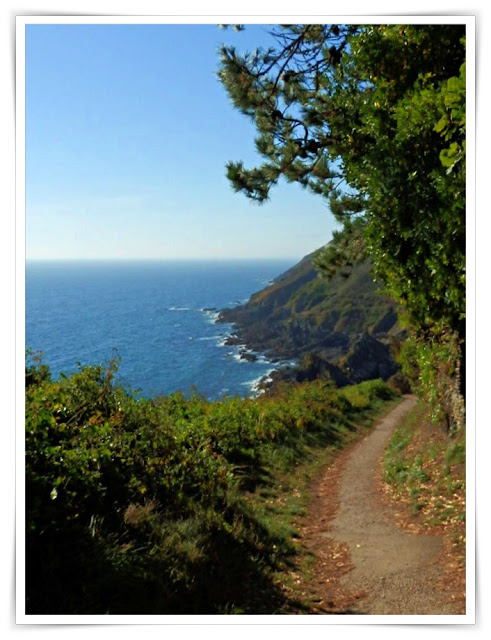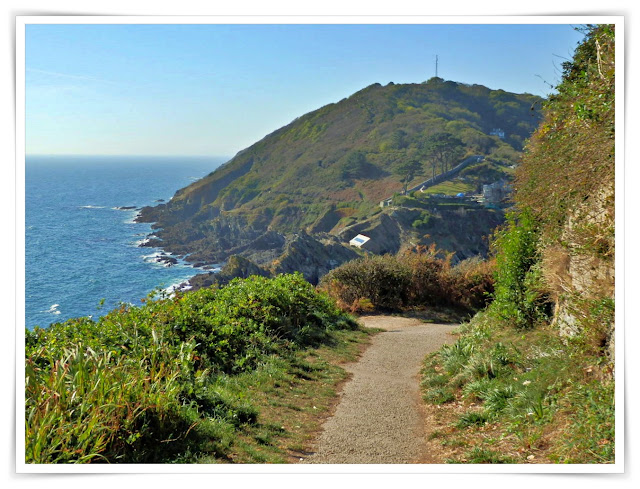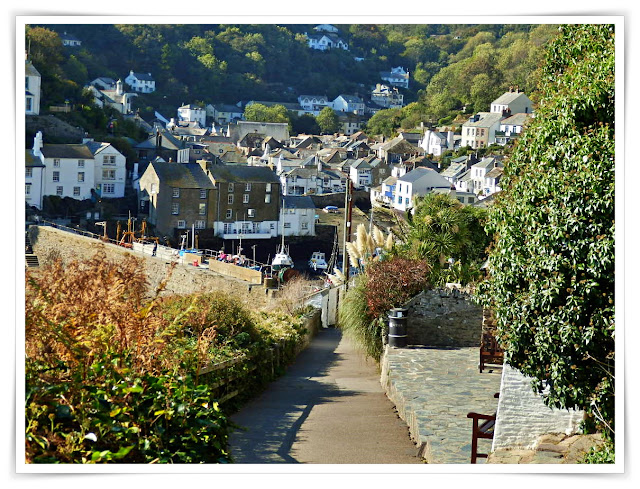Sunday 10 February 2019
Looe, Cornwall On A Cloudy Day
Yesterday's Post featured Polperro. Just along the coast is Looe. The photo was taken on a cloudy day, just before the rain arrived. But people still looked for treasures along the beach.
Saturday 9 February 2019
Walking The South West Coast Path Into Polperro, Cornwall
A few photos walking the South West Coast Path and approaching the village of Polperro.
Lots of ups and downs as we walk the coastal path. In the photo below you can just see the top of the small Polperro lighthouse at Spy House Point. Built in 1911, it is only ten feet tall but the light can be seen for eight miles. There is a track down to the lighthouse.
The path gradually starts to go downhill.
Finally we reach the outskirts of Polperro - still downhill!
At last, Polperro harbour and the tide is out. The old fishing village is like stepping back in time, with cottages clinging to the hillside - a great place to visit.
Lots of ups and downs as we walk the coastal path. In the photo below you can just see the top of the small Polperro lighthouse at Spy House Point. Built in 1911, it is only ten feet tall but the light can be seen for eight miles. There is a track down to the lighthouse.
The path gradually starts to go downhill.
Finally we reach the outskirts of Polperro - still downhill!
At last, Polperro harbour and the tide is out. The old fishing village is like stepping back in time, with cottages clinging to the hillside - a great place to visit.
Friday 8 February 2019
Par Sands : Photos of Beach and Surroundings
 |
| Grasses on the sand dunes at Par |
Golden grasses are still on the sand dunes. The beach is very flat and the tide goes out quite a long way, leaving seaweed and the like behind. To the nearside of the beach the scenery is very pleasant - and it's possible to walk along the cliffs for many miles.
 |
| Par Beach, with the tide out |
 |
| Rocks on the beach |
 |
| Clay works at the far end of the beach |
 |
| Dog walkers on the beach |
 |
| Caravans at Par Sands |
 |
| Seagull on watch at the lake |
 |
| Geese, ducks and other birds at the lake |
 |
| Chalets at Par Sands |
Thursday 7 February 2019
The Mysterious Creatures Guarding Helman Tor, Cornwall
The granite dinosaur casts his eye over Bodmin Moor. He has a good vantage point as he silently observes from the top of Helman Tor. The views stretch for miles. On a clear day it is said that Cornwall's south and north coastlines can be seen.
As well as the dinosaur there is a giant turtle or maybe a tortoise.
Okay, okay, a stretch of imagination perhaps, but there are many strange shapes created by the natural granite boulders on Helman Tor. It's fun to see where your imagination takes you.
The shapes and scenery have been viewed by man since Neolithic times - some 4000 years ago. A settlement was created here and homes erected from stones and rocks. Some of the later boundary walls can still be seen - they are there to be touched.
The prominence of the Tor in the landscape may have given the settlement a strategic position for ceremonial and economic functions - a place to meet, worship and trade.
Over the years the granite boulders and rocks have created such strange shapes and patterns on the landscape.
The weather can change quickly on the moors, as perhaps the photos illustrate - from bright blue to drab skies as the wind directions change.
The photo below shows the Helman Tor Logan Stone or Men Omborth in the Cornish language,
Logan stones are balance stones - they can sometimes be moved by hand despite their great weight. It is believed that Druids used these for their rites and rituals. Uneducated people would believe that the priests had magical powers as they moved such huge granite boulders without any effort.
Helman Tor is away from the main Cornish tourist trail and is reached by driving or walking along very narrow roads - which are often single track. So, if driving you have to keep fingers crossed that nothing is coming in the opposite direction - as one of you will have to be good at reversing!
When visiting the Tor I have rarely seen any other people. Though on one occasion I did see many wild ponies at the top - which was quite magical.
As well as the dinosaur there is a giant turtle or maybe a tortoise.
Okay, okay, a stretch of imagination perhaps, but there are many strange shapes created by the natural granite boulders on Helman Tor. It's fun to see where your imagination takes you.
The shapes and scenery have been viewed by man since Neolithic times - some 4000 years ago. A settlement was created here and homes erected from stones and rocks. Some of the later boundary walls can still be seen - they are there to be touched.
The prominence of the Tor in the landscape may have given the settlement a strategic position for ceremonial and economic functions - a place to meet, worship and trade.
Over the years the granite boulders and rocks have created such strange shapes and patterns on the landscape.
The weather can change quickly on the moors, as perhaps the photos illustrate - from bright blue to drab skies as the wind directions change.
The photo below shows the Helman Tor Logan Stone or Men Omborth in the Cornish language,
Logan stones are balance stones - they can sometimes be moved by hand despite their great weight. It is believed that Druids used these for their rites and rituals. Uneducated people would believe that the priests had magical powers as they moved such huge granite boulders without any effort.
When visiting the Tor I have rarely seen any other people. Though on one occasion I did see many wild ponies at the top - which was quite magical.
Wednesday 6 February 2019
The Cave On Charlestown Beach, Cornwall
 |
| Cave on Charlestown Beach |
 |
| Inside Cave |
 |
| Looking Upwards |
We go back to the days of smuggling. The smugglers would beach their boat and rush their contraband to the cave. There would be a rope dangling through the hole and this would be used by the smugglers associates to heave the goods to the top. They could then transfer the smuggled goods to a safe house - and the boat would sail away before the customs men could take any action.
A bit fanciful perhaps!
The rocks and stones below are just because I quite like rocks and stones.
 |
| Rocks & Stones, Charlestown Beach |
Tuesday 5 February 2019
Walking The Beach At Charlestown, Cornwall
 |
| Charlestown |
 |
| Tunnel and steps to Charlestown Beach |
 |
| The cliffs at the end of Charlestown beach |
 |
| Rocks and stones at the end of Charlestown beach |
 |
| Returning to Charlestown Harbour |
Monday 4 February 2019
Lerryn Bridge, Cornwall and How It Looked In 1890
 |
| How Lerryn Bridge Looks Today |
Anyway, no matter, the photo above is of Lerryn Bridge in Cornwall and surprise, surprise the vintage photo below is how the same scene would have looked in 1890. Not too different really - other than the children may well have moved on since then!
 |
| How Lerryn Bridge Looked in 1890 |
In the 1500s and 1600s smuggling was a way of life in the village. One of the lanes is called Brandy Lane, named after the smugglers favourite tipple. In the nearby Ethy woods there is an entrance to a tunnel which is said to lead to Ethy House - where the contraband was stashed and hidden from the Excise Men.
There's usually a story in Cornwall!
Subscribe to:
Posts (Atom)
FEATURED POST
My Garden in Cornwall
There still isn't much colour in our garden at the moment, here in Cornwall. I think Spring must have forgotten us. On the opposite ...
















